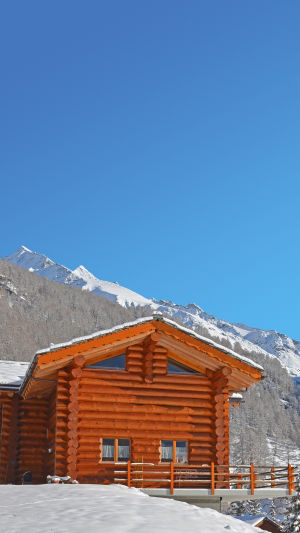What exactly does the Alps represent to climbers and why are they so desirable?
The Alps are located in south-central Europe and cover many European countries, mainly Italy, France, Switzerland and Liechtenstein, with its branches also reaching into Austria, Germany and Slovenia.
Many of Europe's great rivers such as the Danube, the Rhine, the Po and the Rhone originate here.
Located in the Swiss Alps and just outside a charming village on the Sarier mountain, lies the beautiful Sarier chalet, built on the slopes of the Sarier mountain, which takes its name from a small village on the slopes of the Swiss Alps.
Designed and built by Lappi Saez Architecture Studio.
The rickety exterior of the chalet may not attract many eyes, but this is exactly what the architects hoped to achieve.
In contrast to the exterior, the interior is warm.
An architectural reflection of the ever-changing seasons, and the interior is constructed almost entirely of oak panels, which with the help of the wood, ensure that the home stays warm in the winter months.
The interior of the chalet is cleverly designed and makes very efficient use of the smallest of spaces.
Below ground level, there is a basement with a living room and a bathroom built in. Above the basement is the ground floor with a very spacious kitchen, dining and living area for family and friends to spend quality time together around the warm wood-burning stove.
There is another floor above, which is a loft with a beautiful bedroom with a large window for stargazing and bedroom lights to illuminate the wonderful nights in the mountains.
The Alpine chalet system in the Alps provides a great deal of convenience for outdoor activities in the Alps, including hiking, climbing and skiing.
Some of these chalets are in operation and these offer simple beds, standard meals, and some essential information.
Other chalets are unguarded and more akin to shelters, where there is also emergency food.
You can stay overnight and leave some modest expenses in a small box, and just register and report if you use the food inside in good time.
Many of the chalets have a long history.
Some converted from shelters left by miners, some from herders' and hunters' huts, and some purpose-built huts for climbers, many of which are hundreds of years old and still in use.
Most of the chalets are now managed by local chalet associations and serve climbers and skiers.
Mountaineers can stay in a chalet for one or more days to climb a nearby peak. .
As the chalets provide basic services of food and accommodation, climbers only need to bring their own climbing gear, which greatly enhances the convenience of climbing.
Many of the chalets in operation are very well planned and have special gear rooms where everyone keeps their gear.
They only needs to take their clothes and valuables into the bedrooms. There are also bathrooms and some have showers.
The ancillary facilities also include a small bar where beer, wine and drinks can be served and, more importantly, a communal space for socialising.
Many of the chalets also have open-air terraces and rescue platforms for helicopters.





